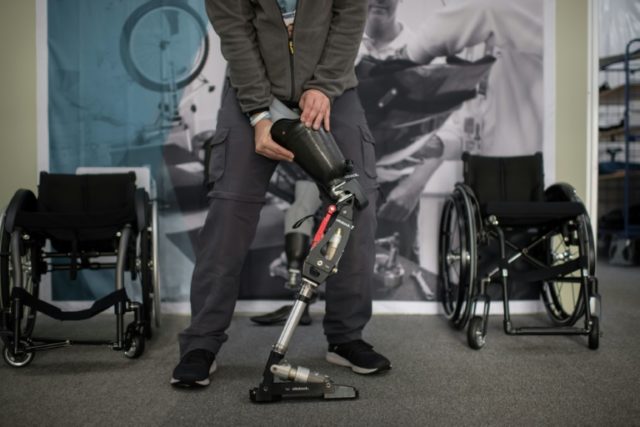Pyeongchang (South Korea) (AFP) – Turkish skier Mehmet Cekic thought his Winter Paralympic dreams had come to an early end when the foot of his prosthetic leg cracked during a practice run in Pyeongchang.
But a team of technicians quickly patched up the device, allowing him to compete, one of many athletes given vital help at a hi-tech Winter Paralympics workshop.
With 567 Paralympians in Pyeongchang competing in high-octane sports from sledge ice hockey to downhill skiing, damage to prosthetic limbs and specialist sports equipment is common.
The centre run by German prosthetics giant Ottobock, which is filled with a huge array of equipment and manned by 23 technicians, seeks to ensure that mishaps don’t prevent athletes from competing.
As well as fixing prosthetic limbs, the technicians based in a warehouse in the athletes’ village also patch up wheelchairs and repair gear such as para-ice hockey sledges and sit-skis, used by skiers with leg impairments.
“Every repair is different,” Peter Franzel, a director at Ottobock and head of the workshop, told AFP.
“It’s not like changing oil in a car, it’s really highly individual.”
Athletes can drop in to the 300-square-metre (3,200-square-foot) centre during opening hours, from 8:00 am to 9:00 pm, and it also has a 24-hour emergency phone line.
Most repairs take place on workbenches, where technicians tinker with sit-skis, wheelchairs, and artificial legs, while athletes chat and wait for work to be finished.
The workshop is home to a mind-boggling array of equipment — from welding machines to metal grinders and high-powered drills, and sewing machines for leather straps and wheelchair fabric.
Ottobock shipped about 8,000 spare parts out for the Games, and can also order extras from its warehouse in Seoul if needed. They also have repair centres at several of the venues.
– Trouser trouble –
The company, a major producer of prosthetics and wheelchairs, has offered repair services at every Paralympic Games since Seoul in 1988, when a handful of technicians armed with a tool box worked out of a small pavilion.
At Pyeongchang the technicians come from nine countries, including Germany, the United States, Finland and Japan, meaning they can speak an array of languages and cater to the global line-up of athletes.
Repair services are free for all athletes, although prosthetics is normally an expensive business.
A specialised prosthetic leg for skiing can cost around $18,000. A high-quality prosthetic for everyday use — which contains a microprocessor that continually monitors the leg’s movements — can cost up to $60,000.
The workshop has faced heavy demand in Pyeongchang. It has so far carried out over 340 repairs during the Paralympics, higher than the 260 it had expected for the entire Games.
Franzel said 60 percent of repairs were on wheelchairs as they were the most common piece of equipment among Paralympians.
But the technicians try to accommodate every request, no matter how unusual.
The first repair they carried out at the Games was on a broken pair of glasses, while several Japanese para-athletes found their trousers were too long — so the workshop turned them up.
For Cekic — Turkey’s sole Winter Paralympian, who lost his left leg eight years ago in a motorcycle accident — the service proved invaluable.
The workshop did not initially have an artificial foot to replace the one he had broken.
So they attached the foot from his everyday prosthesis on to his specialised sports limb, allowing him to compete in his first event.
The workshop ordered a new foot, which arrived after two days and Cekic’s sports prosthesis was fully repaired.
“It’s great for athletes to have a centre like this, we really need it,” said the 48-year-old.

COMMENTS
Please let us know if you're having issues with commenting.